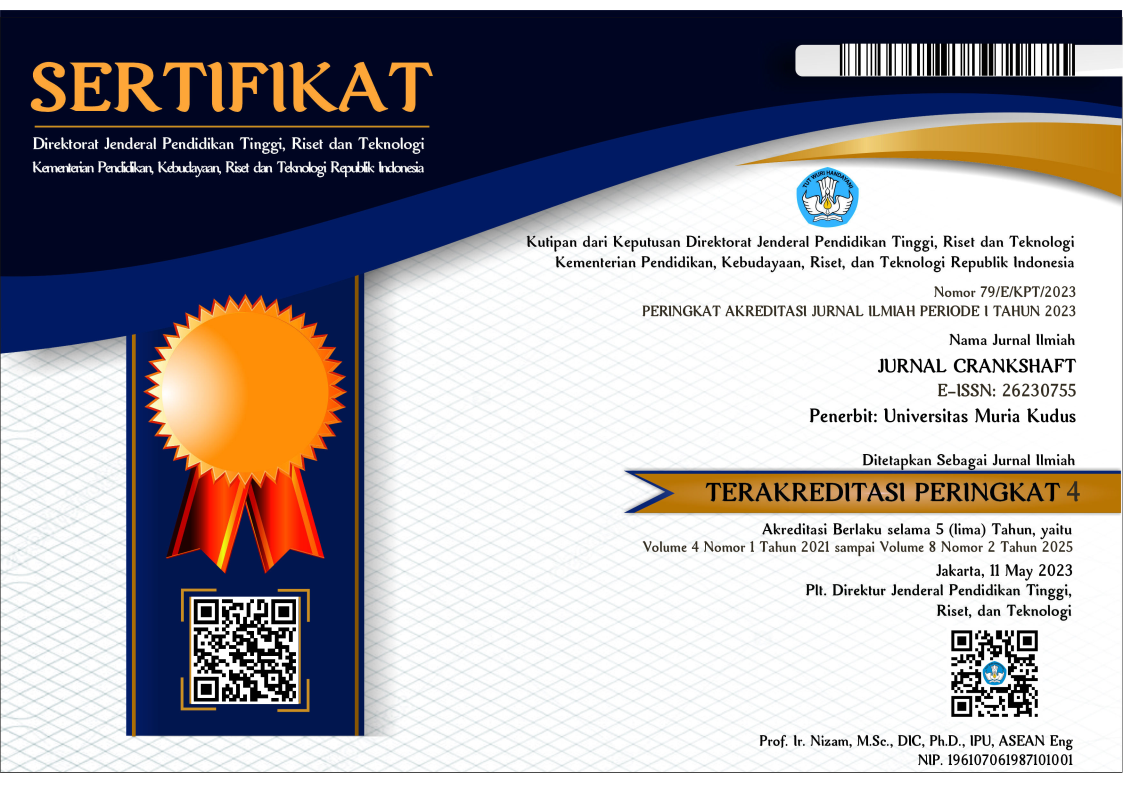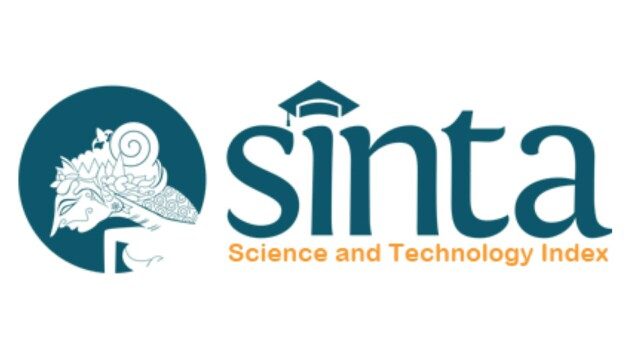Peningkatan Kualitas Hasil Assembling Shock Absorber Tipe C 50 Di PT KAI (Persero) UPT Balai Yasa Surabaya Gubeng Melalui Pemilihan Viskositas Oil Damper
Sari
Kereta Api merupakan moda transportasi penumpang dan barang yang memiliki berbagai keunggulan. Diantaranya kapasitas angkut yang besar, efisien, aman, serta nyaman. Salah satu faktor yang menunjang keamanan dan kenyamanan perjalanan Kerata Api adalah sistem suspensi. Sistem suspensi ini berfungsi meredam getaran akibat pergerakan kereta dan rel. Komponen penting dalam sistem suspensi adalah shock absorber, yang berfungsi meredam gaya osilasi dan mendispersikan energi kinetik dari guncangan. Penelitian ini bertujuan untuk mengetahui prosedur assembling shock absorber yang sesuai standar, viskositas oil damper yang tepat, serta pengaruh kondisi komponen terhadap kualitas shock absorber di PT KAI (Persero) UPT Balai Yasa Surabaya Gubeng. Penelitian ini menggunakan pendekatan eksperimental dan komparatif untuk membandingkan dua variabel, yaitu viskositas oli SAE 10 dan SAE 40. Parameter pengujian meliputi grafik perbandingan antara force dan velocity, peak velocity, gas test, dan seal drag. Hasil menunjukkan bahwa oli SAE 40 dengan viskositas tinggi menghasilkan redaman yang lambat dan tidak memenuhi standar, terutama pada posisi rebound pada kecepatan 95mm/sec dengan force 363,19Kgf (di bawah batas toleransi 370-630 Kgf). Hasil gas test menunjukkan 6,67Kgf, serta pengujian seal drag sebesar 20,43Kgf telah melebihi standar 5-15Kgf. Sebaliknya, oli SAE 10 menunjukkan performa yang lebih baik. Pada posisi rebound, gaya tetap dalam batas standar, yaitu sebesar 401,45Kgf pada kecepatan 102,52mm/sec. Gas test sebesar 4,23 Kgf dan seal drag sebesar 7,07 Kgf juga memenuhi standar. Sehingga proses assembling dan viskositas yang dipakai dalam assembling sangat berpengaruh terhadap hasil pengujian. Pemilihan komponen shock absorber yang tidak sesuai standar dapat mempengaruhi hasil dari gas test dan seal drag. sebab berdampak pada hasil pengujian yang tidak sesuai standar.
Teks Lengkap:
PDFReferensi
[1] D. R. Zahro, “Sisi Kompresi dan Ekspansi dengan Perubahan Diameter Piston , Orifice dan Piston Rod terhadap Gaya Redam Shock Absorber dan Respon Dinamis,” Institut Teknologi Sepuluh Nopember, 2017.
[2] Nitish and A. K. Singh, “Design of robust active suspension system for performance improvement and vibration control of railway vehicle,” in Proceedings of the Institution of Mechanical Engineers, Part C: Journal of Mechanical Engineering Science, 2024. doi: 10.1177/0954406211402139.
[3] R. K. Tadepalli, C. S. P. Rao, K. N. Rao, and D. R. Sastry, “Semi Active Vibration Control Device for Secondary Suspension of a Railway Wagon to Improve Ride Comfort,” Adv. Sci. Technol., vol. 120, pp. 127–138, 2022.
[4] S. K. Sharma, R. C. Sharma, Y. Choi, and J. Lee, “Modelling and Dynamic Analysis of Adaptive Neuro-Fuzzy Inference System-Based Intelligent Control Suspension System for Passenger Rail Vehicles Using Magnetorheological Damper for Improving Ride Index,” Sustain., vol. 15, no. 16, pp. 1–24, 2023, doi: 10.3390/su151612529. [5] B. Nieradko-Iwanicka, “Hand-arm vibration syndrome,” 2019. doi: 10.1201/b13467-61.
[6] L. Fu, T. Guo, and G. Li, “Investigation on damping performance of new type oscillator-liquid combined damper,” Int. J. Mech. Sci., vol. 135, pp. 53–62, 2017, doi: 10.1016/j.ijmecsci.2017.11.018.
[7] K. V. Chernyshov, K. V. Chernyshov, V. . Kotov, and R. R. Sanzhapov, “Analysis of shock absorber resistance impact on load safety, continuous wheel rolling and energy loss in vehicle suspension,” Russ. Automob. Highw. Ind., vol. 19, 2022.
[8] P. E. Urassa, “Dynamic Analysis of Bogie Wheelset- a Review,” Int. J. Eng. Appl. Sci. Technol., vol. 6, no. 2, pp. 13–16, 2021, doi: 10.33564/ijeast.2021.v06i02.003.
[9] M. Yonglin et al., “Bogie wheelset having steerable rubber wheels, and rubber-tired bogie,” 2021, [Online]. Available: 10.1016/b978-0-12-824315-2.00735-1
[10] A. Zhao, J. Huang, and J. Q. Sun, “Estimation of wheel–rail structural interactions from motion signals of high-speed train bogie: Estimation of wheel–rail interactions,” Int. J. Dyn. Control, vol. 11, no. 4, pp. 1609–1620, 2023, doi: 10.1007/s40435-022-01085-2.
[11] W. Liujie, T. Jiawei, S. Dongsheng, C. Zan, L. Yang, and Z. Junxiao, “Shock absorber, vehicle and method for improving driving stability of vehicle,” 2021 [12] S. Treskin, E. Dulskly, V. Kruchek, and P. Ivanov, “Analysis of the use of hydraulic vibration dampers in spring suspension structures of railway rolling stock,” in Proceedings of Petersburg Transport University, 2024, pp. 598–608. doi: 10.20295/1815-588X-2024-03-598-608.
[13] L. Schickhofer and J. Wimmer, “Fluid–structure interaction and dynamic stability of shock absorber check valves,” J. Fluids Struct., vol. 110, no. April, pp. 1–7, 2022.
[14] C. P. Antonio, C. Fabio, D. V. Marco, and G. Giordano, “Variable-damping hydraulic shock-absorber for a vehicle suspension,” 2021
[15] J. Dižo, M. Blatnický, S. Steišūnas, and G. Vaičiūnas, “Influence of Suspension Parameters Changes of a Railway Vehicle on Output Quantities,” LOGI - Sci. J. Transp. Logist., vol. 10, no. 1, pp. 20–29, 2019, doi: 10.2478/logi-2019-0003.
[16] Y. Yao, X. Chen, H. Li, and G. Li, “Suspension parameters design for robust and adaptive lateral stability of high-speed train,” Veh. Syst. Dyn., vol. 61, no. 4, pp. 943–967, 2023, doi: 10.1080/00423114.2022.2062012.
[17] A. Roghani, R. Pall, and E. Toma, “Procedure for combining field measurements and machine learning to quantify impact of different track parameters on ride quality of railway tracks,” in Proceedings of the Institution of Mechanical Engineers, Part F: Journal of Rail and Rapid Transit, 2021. doi: 10.1177/095440971122500201.
[18] Y. Pan, S. Guo, R. Jiang, Y. Xu, Z. Tu, and L. Zuo, “Performance evaluation of train suspension energy harvesting shock absorber on railway vehicle dynamics,” in ASME 2018 Dynamic Systems and Control Conference, DSCC 2018, 2018, pp. 1–6.
[19] L. Yongjian, “Shock absorber provided with friction force damper and used for train,” 2019
[20] S. Kato, “The Power of Oil : Influence of Shock Absorber Oil on Vehicle Ride and Handling Performance,” 2021, KYB Technical Review.
[21] Z. Georgiev, “Study of Vibrational Behaviour of Shock Absorber in Harshness Frequency Range 20-100 Hz,” Eng. Rural Dev., vol. 22, no. May, pp. 707–713, 2023,
[22] M. R. Eskafi, M. A. A. Kazemi, and K. Nikofer, “Validation of the Results of the Fuzzy Control Systems Method in Optimizing the Dynamic Behavior of Viscoelastic Dampers,” J. Dyn. Manag. Bus. Anal., vol. 2, pp. 128–143, 2024.
[23] I. Țurcan and R. Țurcan, “Quality management and its impact on entrepreneurial activity,” J. Soc. Sci., vol. 6, no. 1, pp. 16–24, 2023.
[24] A. H. Abdi, Darsini, and A. Komariah, “Analisis Kualitas Pelayanan Transportasi Online Gojek Terhadap Kepuasan Mahasiswa Dengan Metode Servqual, KANO, dan QFD,” J. Apl. Ilmu Tek. Ind., vol. 1, no. 2, pp. 73–87, 2020.
[25] I. Ismartaya, L. Hikmat Maulana, W. Simanjuntak, and T. Kartini, “The Impact Of Product Quality And Service Quality On Consumer Satisfaction At Kedai Falsafah Ngopi Bogor, Indonesia,” Int. J. Sci. Technol. Manag., vol. 4, no. 4, pp. 834–841, 2023,
[26] M. Lestari, B. Wibowo, and A. Komariah, “Penentuan Prioritas Strategi Bersaing di UD XYZ dengan Metode SWOT dan AHP,” Senriabdi 2021, vol. 1, no. 1, pp. 33–40, 2021. [27] M. K. Madona Kantidze, “The importance of quality management and its impact on the organization’s reputation,” New Econ., vol. 18, no. 01, pp. 59–63, 2023.
DOI: https://doi.org/10.24176/cra.v8i2.14560
Refbacks
- Saat ini tidak ada refbacks.
##submission.license.cc.by-nc-sa4.footer##
Indexed by:
Jurnal Crankshaft is licensed under a Creative Commons Attribution-ShareAlike 4.0 International License.
Dedicated to:







